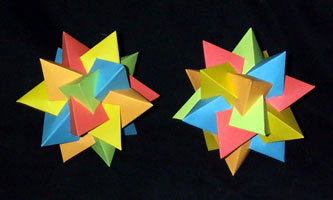A number of attractive tetrahedron 5-compounds can be constructed. The first (left figures) is one of the icosahedron stellations
in which the
vertices of the tetrahedra correspond to the 20 vertices of a regular
dodecahedron. Two tetrahedron 5-compounds of opposite chirality
combine to make a tetrahedron 10-compound
(Cundy and Rollett 1989). A second tetrahedron 5-compound (right figures) is illustrated
above.
These compounds are implemented in the Wolfram Language as PolyhedronData["TetrahedronFiveCompound",
n
]
for
and 2.

The illustration above shows paper sculptures of both handednesses of the tetrahedron 5-compound.
Escher built his own model of the tetrahedron 5-compound as a study for his woodcuts (Bool et al. 1982, p. 146).
These tetrahedron 5-compounds are illustrated above together with their duals and common midspheres.
The common solids and convex hulls are illustrated above. For the first compound, the interior is a regular icosahedron and the convex hull is a regular dodecahedron.
There are two techniques for constructing the compounds. The first, advocated by Wenninger (1989, p. 44) uses 20 identical pieces as illustrated above, each assembled into a small three-piece pyramid. The 20 pyramids are then assembled in rings of five into the solid. The side lengths illustrated in the net are given by
|
(1)
| |||
|
(2)
| |||
|
(3)
| |||
|
(4)
| |||
|
(5)
| |||
|
(6)
|
where
is the golden ratio, for a compound produced starting
from a regular dodecahedron with unit edge
lengths.
A fancier construction is advocated by (Cundy and Rollett 1989). While allegedly simpler than the first construction, its differently shaped pieces actually prove more difficult to assemble correctly in practice. Cundy and Rollett's method involves constructing a base tetrahedron, placing a "cap" around one of the apexes (thus giving an attractive tetrahedron 2-compound as an intermediate step), and then affixing a triangular pyramid to the opposite face. Twelve pyramids of the same type as above are then constructed and attached edge-to-edge in chains of three. The four chains of pyramids are then arranged about the eight vertices of the original two tetrahedra, with the points of coincidence of the three pyramids in each chain attached such that they coincide with intersections of the original two tetrahedra such that five pyramids touch at a single point.
By replacing the solid tetrahedra with beveled struts along its edges, the attractive structure above is obtained.